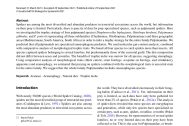Obsah
Spiders are among the most diversified and abundant predators in terrestrial ecosystems across the world, but information on their prey is limited. Particularly, there is paucity of data for prey-specialised species, such as palpimanid spiders. Here we investigated the trophic strategy of four palpimanid species (Diaphorocellus biplagiatus, Otiothops birabeni, Palpimanus gibbulus, and P. potteri) representing all three subfamilies (Chediminae, Otiothopinae, Palpimaninae) and three geographic areas (Mediterranean, South America, South Africa) in order to infer a trophic strategy for the entire family Palpimanidae. We predicted that all palpimanids are specialised araneophagous predators. We used molecular gut-content analysis, combined with comparative analysis of morphological trophic traits. We found all four species to catch spiders more than insects. All species captured spiders belonging to several families, but predominantly those of the cursorial guild. The diet composition did not differ between sexes and juveniles. The breadth of trophic niche was narrow for all species, suggesting stenophagy. Using comparative analysis of morphological traits (thick cuticle, stout forelegs, scopulae on forelegs, and stridulatory apparatus) and araneophagy, we estimated that preying on spiders combined with the morphological traits is ancestral state for the entire family. We suggest that the whole family Palpimanidae includes araneophagous species.



